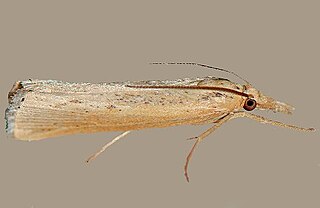Asciodes is a genus of snout moths in the subfamily Spilomelinae of the family Crambidae. The genus was erected by Achille Guenée in 1854 with Asciodes gordialis as type species.
Mimoschinia is a genus of moths of the family Crambidae. It contains only one species, Mimoschinia rufofascialis, the rufous-banded pyralid moth or barberpole caterpillar, which is found in the Caribbean, from Alberta to British Columbia, south to Texas and California and in Mexico.
Mojaviodes is a genus of moths of the family Crambidae. It contains only one species, Mojaviodes blanchardae, which is found in North America, where it has been recorded from Texas.
Nannobotys is a genus of moths of the family Crambidae. It contains only one species, Nannobotys commortalis, which is found in North America, where it has been recorded from eastern Washington to California and Nevada.
Neargyrioides is a genus of moths of the family Crambidae. It contains only one species, Neargyrioides aglaopis, which is found in Australia, where it has been recorded from the Northern Territory and Queensland.
Nechilo is a genus of moths of the family Crambidae. It contains only one species, Nechilo macrogona, which is found in Australia, where it has been recorded from Victoria.
Neocataclysta is a genus of moths of the family Crambidae. It contains only one species, Neocataclysta magnificalis, the scrollwork pyralid moth, which is found in North America, where it has been recorded from Florida, Georgia, Maine, Massachusetts, Mississippi, New Jersey, New York, North Carolina, Nova Scotia, Ohio, Ontario and South Carolina.
Neocymbopteryx is a genus of moths of the family Crambidae. It contains only one species, Neocymbopteryx heitzmani, which is found in North America, where it has been recorded from Arkansas.

Niphograpta is a genus of moths of the family Crambidae. It contains only one species, the water hyacinth moth. It is native to the Amazon basin, but has been introduced in North America, Africa and Australia to control the spread of water hyacinth.
Nyctiplanes is a genus of moths of the family Crambidae. It contains only one species, Nyctiplanes polypenthes, which is found in Australia, where it has been recorded from Queensland.

Pseudoschinia is a genus of moths of the family Crambidae. It contains only one species, Pseudoschinia elautalis, which is found in North America, where it has been recorded from Arizona, California, Nevada, New Mexico and Texas.

Perispasta is a genus of moths of the family Crambidae. It contains only one species, Perispasta caeculalis, or Titian Peale's pyralid moth, which is found in North America, where it has been recorded from Quebec west to British Columbia, south to Florida, Texas and Colorado. The habitat consists of fields and meadows. Both the genus and species were first described by Philipp Christoph Zeller in 1875.
Portentomorpha is a genus of moths of the family Crambidae. It contains only one species, Portentomorpha xanthialis, which is found from Texas to Louisiana and Florida, the West Indies and from Mexico to Bolivia.
Rhodocantha is a genus of moths of the family Crambidae. It contains only one species, Rhodocantha diagonalis, which is found in North America, where it has been recorded from New Mexico and Texas.
Raphiptera is a genus of moths of the family Crambidae. It contains only one species, Raphiptera argillaceellus, the diminutive grass-veneer, which is found in eastern North America, where it has been recorded from Labrador, Ontario, Wisconsin, Connecticut, New York, Quebec, Alberta and Michigan. The range extends to Florida and Texas in the south-east and Costa Rica in Central America. The habitat consists of bogs.

Sclerocona is a genus of moths of the family Crambidae which contains only one species, Sclerocona acutella. It was first described by the Prussian biologist Eduard Friedrich Eversmann in 1842.
Tanaobela is a genus of moths in the superfamily Pyraloidea containing only one species, Tanaobela chrysochlora, which is found in Australia, where it has been recorded from Queensland. Its affiliations are disputed.

Tehama is a genus of moths of the family Crambidae. It contains only one species, Tehama bonifatella, the western lawn moth, which is found in Greenland and North America, where it has been recorded from Alberta, British Columbia, California, Colorado, Labrador, Manitoba, Nevada, Quebec and Washington. The habitat consists of grasslands.
Aphomia fulminalis is a species of snout moth in the genus Aphomia. It was described by Zeller in 1872, and is known from the United States, where it has been recorded from Arizona, Connecticut, Illinois, Massachusetts, Maryland, Maine, Mississippi, New York, Pennsylvania, Texas and Nova Scotia.

Sciota uvinella, the sweetgum leafroller moth, is a species of snout moth in the genus Sciota. It was described by Ragonot in 1887. It is found in North America, where it has been recorded from New Jersey to Florida, west to Texas and Kentucky.





